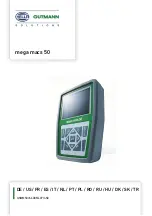
Monitoring
3-18
LIFEPAK 20e Defibrillator/Monitor Operating Instructions
Figure 3-5
Phases of the Respiratory Waveform
Respiratory Baseline.
Elevation of the waveform baseline (I–II segment) usually represents
rebreathing CO
2
. This elevation usually is accompanied by gradual increases in the EtCO
2
value.
Rebreathing CO
2
is common in circumstances of artificially produced increased dead space and
hypoventilation. Precipitous rises in both baseline and EtCO
2
values usually indicate
contamination of the sensor.
Expiratory Upstroke.
In the normal waveform, the rising phase (II–III segment) is usually steep.
When this segment becomes less steep, CO
2
delivery is delayed from the lungs to the sampling
site. The causes of this delay can be physiologic or mechanical and include bronchospasm,
obstruction of the upper airway, or obstruction (or kinking) of an endotracheal tube (ETT).
Expiratory Plateau.
The plateau of the waveform, which represents the remainder of expiration
(III-IV segment), should be nearly horizontal. The end of the plateau represents the EtCO
2
value.
Upward slanting of the expiratory plateau occurs when there is uneven emptying of the alveoli.
Similar to the diminished slope of the Expiratory Upstroke, this pattern can occur in asthma,
chronic obstructive pulmonary disease (COPD), partial upper-airway obstruction, or partial
mechanical obstruction such as a partially kinked ETT.
Inspiratory Downstroke.
The fall to baseline (IV-V segment) is a nearly vertical drop. This slope
can be prolonged and can blend with the expiratory plateau in cases of leakage in the exhale
portion of the breathing circuit. The peak EtCO
2
value (IV) is often not reached. Relying on the
numeric end-tidal value without observing the breathing waveform may obscure the presence of
a leak.
EtCO
2
Monitoring Procedure
The EtCO
2
monitor is activated when the FilterLine set is attached. Initialization, self-test, and
warm-up of the EtCO
2
monitor is typically less than 30 seconds, but may take up to two and
one-half minutes.
Carefully read the Instructions for Use that are provided with the FilterLine for placement
instructions, use instructions, warnings, cautions, and specifications.
CAUTION!
Possible equipment damage.
Failure to replace a broken or missing CO
2
port door may allow water or particulate
contamination of the internal CO
2
sensor. This may cause the CO
2
module to malfunction.
Possible equipment damage.
Do not use excessive force when connecting the FilterLine to the CO
2
port. This may damage
the connector.
IV
V
II
III
I
Summary of Contents for LIFEPAK 20
Page 2: ...LIFEPAK 20e DEFIBRILLATOR MONITOR Operating Instructions ...
Page 3: ......
Page 4: ...LIFEPAK 20e DEFIBRILLATOR MONITOR OPERATING INSTRUCTIONS ...
Page 15: ......
Page 49: ......
Page 111: ......
Page 155: ......
Page 171: ......
Page 181: ......
Page 183: ......
Page 189: ......
Page 191: ......
Page 195: ......
Page 199: ......
Page 201: ......
Page 205: ......
Page 209: ......
Page 211: ......
Page 213: ......
Page 215: ......
Page 221: ......
Page 226: ......
















































